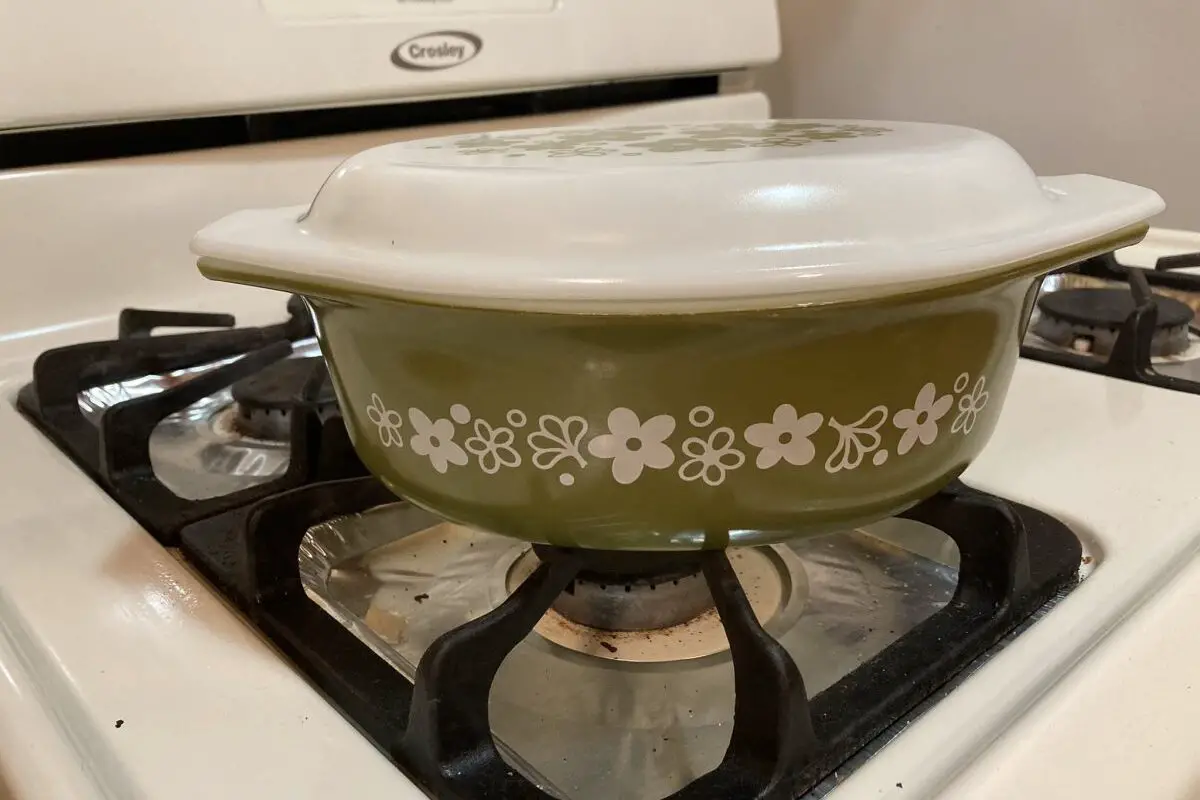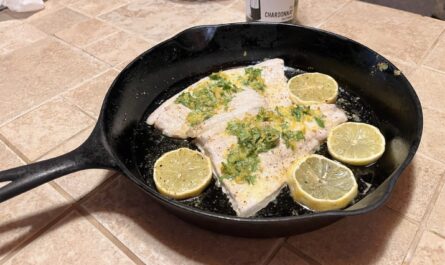In an article I wrote back in May, I told about finding out that our beloved vintage Corelle dishes contained Lead in the decorative pattern surrounding the dish. As a result, we bought new dishes, removed the old Corelle plates from the cupboard, and boxed them up in the garage. Do I have the same issue with vintage Pyrex?
This incident alerted me that it’s entirely possible that other items in our cottage may contain Lead, cadmium, and other heavy metals that would be toxic if inadvertently ingested. But, since we now have a granddaughter who visits frequently, we were not going to risk it. So the search began in our Michigan cottage. It didn’t take long.
Deep In the Cupboard – A Green Vintage Pyrex Casserole Dish
This vintage Pyrex glass ovenware has been used for over 20 years. I think we acquired it in a thrift store in town after we bought our place in Caseville. It’s a perfect size, cleans up quickly, and is practically indestructible. The green flower pattern held up well but looked worn and faded.
I researched the Corning Museum of Glass and discovered this 1 ½ quart casserole dish is from a set called Spring Bloom Green. This design was sold for nearly a decade, having been released in two iterations. The first of which was available between 1972 and 1979. The design embraced the popular trend in the 1970s with the color avocado green in kitchens. This dish has background colors of white and avocado green with clusters of large flowers, leaves, and dots.
I found that this vintage cookware is very collectible. Collectors call the decorative pattern Crazy Daisy. A quick search revealed several Esty and eBay shops selling this particular used dish from $20 to $50.
We Use This Dish All the Time – does vintage Pyrex have Lead?
I returned to the site Lead Safe Mama to see if they had tested this particular dish. Sure enough, Tamera Rubin had this specific pattern well covered. Her testing method showed the dish pattern Vintage Pyrex “Spring Blossom Green” pattern casserole has lead levels registering at 110,000 parts per million in the white flowers. According to Tamera, the safety standard is lead levels at no more than 90 parts per million. Yikes!
We gingerly took the dish out of the kitchen and into the garage. This old Pyrex casserole dish is now on the shelf next to the Acetone, Roundup, and Insecticides.
Correspondence with Instant Brands, the Owner of the Pyrex Brand

I was interested in knowing if Pyrex had any guidance or thoughts on the topic. I found out that last year Corelle Brands Became Instant Brands. This company is made up of an extensive collection of iconic brand names such as Pyrex®, Instant®, Corelle®, CorningWare®, Chicago Cutlery®, SnapWare®, and Visions®. Their moniker is “#MadeforTogether.”
So, I posted an email inquiry on the Instant Brands Customer Care Website. I had the following question.
I have an old Pyrex 1.5-quart oval ovenware piece. It has a green flower pattern on the outside. We have used it for years. I just read where a test from Lead Safe Mama said there are high lead levels in the pattern. Is this Pyrex ovenware safe to use every day?
Appreciate any guidance on this topic
Email Question to Instant Brands via Their Customer Care Site
Two Days Later, I received this response:
Thank you for contacting us at Instant Brands, we’re happy to help you.
All of our products meet the safety standards of the time they were made, up to and including today. Pyrex product enamels converted to lead-free in 2006.
We hope this helps. Please feel free to reach out to us if you have any more questions or if we can offer you further support.
Jacob- Instant Brands Customer Care, 1-800-999-3436, support@instantbrands.com, Monday – Friday: 9:30 am – 4:00 pm EST
Email Response Instant Brands Received July 8, 2022
My Translation of What Instant Brands Told Me About Vintage Pyrex
This response was carefully crafted. I’m sure that it’s possible their legal team reviewed it before it was sent out. After spending 30 years with a Fortune 100 company in a lawsuit-crazy world, I appreciate that. So here is my take on Jacob’s response.
- It was lead-free if I bought or acquired a Pyrex item made after 2006. A straight-up answer. That is great to know but not applicable to my 1970s-era vintage Pyrex ovenware. When we replaced the vintage Corelle dishes, we replaced them with new Corelle with no pattern. So that makes me feel good.
- Any Pyrex made before 2006 met the safety standards of the time they were made. – The answer does not go into any further detail. Their attorneys likely made sure of that. I now understand that there were no standards until 1970. In 1970, the FDA started controlling and limiting the Lead used in paint glazes that may come in contact with food. Since then, there have been two updates issued by the FDA.
The key phrase that Instand Brands used was, “All of our products meet the safety standards of the time they were made, up to and including today.”
My take is that this particular vintage Pyrex dish from the 1970s contains Lead. The company hides behind the statement saying they complied with the safety standards of 50 years ago. But they will not indicate if this Pyrex dish was safe to use then or today.
Bottom Line – Is Vintage Pyrex Safe To Use?
No one has been able to establish that these old Pyrex pieces are safe at this time. However, multiple investigations have proven and verified that lead-painted glassware poses a potentially considerable danger to human health.
I found no one, I mean NO ONE, will go on the record and say that using these vintage Pyrex or Corelle dishes is perfectly safe. The best practice suggestion seems to come from Corelle Brands. In an email response about older dishware. Corelle stated:
“Before the 1990s, virtually all glass and ceramic ware made anywhere in the world contained Lead as a primary ingredient in the decorating fluxes and glazes. All our products have been Lead-free since the mid-2000s. Lead content has never been regulated until recently. We recommend using the items you have as decorative pieces. We hope this information is helpful.”
We will heed the manufacturer’s advice.
Bibliography: Peer-Reviewed Scientific Studies About Lead in Cookware & Dishes
The following list is a bibliography of studies of cookware, glasses, and dishes concerning lead content and what happens with various types of use, such as using in a microwave or with acidy foods.
Lead in Decorative Drinking Glasses
Summary: According to one study, lead and cadmium levels in enameled drinking glasses and other items can be harmful. The University of Plymouth conducted 197 tests on 72 new and used drinking glass goods, including tumblers, beer and wine glasses, and jars. They discovered Lead in 139 cases and cadmium in 134, both on the surface of the glasses and, in some cases, on the rims, with lead concentrations up to 1000 times higher than the permitted threshold…
See Drinking glasses can contain potentially harmful levels of Lead and cadmium
Using Cookware Containing Lead in Microwaves
Summary: In 1996, research was done using pre-1950s US-made ceramic tableware obtained from antique stores and flea markets. They discovered dangerous lead concentrations (>3 microg/ml) in microwave leachates from dishes containing uranium-containing, copper-containing, and flowery over-the-glaze decorations. This study implies that using such plates for popular microwave foods might result in unacceptably high levels of lead intake…
Use of Cookware with Foods Containing High Acid
Summary – Dinnerware with overglaze patterns can leach harmful metals into meals in sufficient quantities to pose a health risk. Lead concentrations of up to 610 micrograms/ml and cadmium concentrations of up to 15 micrograms/ml were observed after filling dishes produced in the United States before 1970 with 4 percent acetic acid for 24 hours. More than half of the dishes tested for Lead (78 of 149) had levels that exceeded the US Food and Drug Administration (FDA) allowed value of 3.0 micrograms/ml.
Testing Results of Imported Dishware Commonly Found in Retail
Summary – Imported dishes can endanger human health: (1) tableware containing dangerous metals at excessive levels may enter the US, and (2) imported ornamental ceramic plates may be incorrectly labeled for authorized food usage. Non-random samples of dishes were obtained in fresh condition from US retail shops and subjected to 24-hour acid leaching testing in the current investigation. As a result, two of 28 imported ceramic tableware designs had lead levels that exceeded US Food and Drug Administration (FDA) guidelines. In contrast, ten different patterns had lead concentrations that exceeded California Proposition 65 (CA 65) restrictions.
See – Acid extraction of Lead and cadmium from newly-purchased ceramic and melamine dinnerware
Sources For this Story on Vintage Pyrex
“Sources of Lead.” Sources of Lead, www.health.ny.gov, 1 Apr. 2010, https://www.health.ny.gov/environmental/lead/sources.htm#paint.
Turner, Andrew. “High Levels of Migratable Lead and Cadmium on Decorated Drinking Glassware – ScienceDirect.” High Levels of Migratable Lead and Cadmium on Decorated Drinking Glassware – ScienceDirect, www.sciencedirect.com, 22 Oct. 2017, https://www.sciencedirect.com/science/article/abs/pii/S0048969717328747?via%3Dihub.
Rubin, Tamera. “#Leaded: Vintage ‘Spring Blossom Green’ Pattern (Crazy Daisy) Pyrex Casserole, c. 1972 to 1979.” Lead Safe Mama, tamararubin.com, 23 Nov. 2017, https://tamararubin.com/2017/11/vintage-spring-blossom-green-pattern-pyrex-casserole/.
Corning Museum of Glass. “Spring Blossom Green | Pyrex.” Corning Museum of Glass, Corelle Brands, 1 Jan. 1972, https://pyrex.cmog.org/pattern-library/spring-blossom-green.
Sheets, R. W., et al. “Effect of Microwave Heating on Leaching of Lead from Old Ceramic Dinnerware – PubMed.” PubMed, pubmed.ncbi.nlm.nih.gov, 5 Apr. 1996, https://pubmed.ncbi.nlm.nih.gov/8854945/
Sheets, R. W. “Extraction of Lead, Cadmium, and Zinc from Overglaze Decorations on Ceramic Dinnerware by Acidic and Basic Food Substances – PubMed.” PubMed, pubmed.ncbi.nlm.nih.gov, 30 Apr. 1997, https://pubmed.ncbi.nlm.nih.gov/9151439/.
Discover more from Thumbwind
Subscribe to get the latest posts sent to your email.




